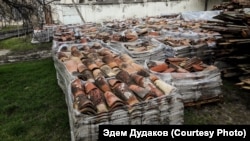Centuries-old oak beams ripped out and concrete poured in their place. Priceless tiles removed. Murals nearly erased by high-pressure streams of water.
These are reports from the restoration of a 16th-century Turkic palace near the southern tip of Russia-occupied Crimea.
For the Moscow-installed local authorities, a firm with apparently no experience in restoring historic buildings seemed to be the perfect choice to renovate the Khan's Palace in Bakhchisaray, some 50 kilometers southwest of the Black Sea port city of Sevastopol.
Critics are shocked, warning that irreparable harm is being done at the site, which in 2013 was listed by UNESCO as a potential addition to its World Heritage List.
"The palace is threatened with losing its historic value. The workers have already chopped up old beams, used concrete on parts of the structure. They are vandals. That's not how restoration is done," says Edem Dudakov, the former head of the Crimean Committee on Interethnic Relations and Deported Peoples.
The outrage is so deep that Kyiv has called on UNESCO to demand that Moscow abide by international norms and avert further steps that could cause even more irreparable damage at the site, media have reported.
UNESCO (the UN Education, Scientific, and Cultural Organization), has been tightlipped on the matter.
"At this stage, we cannot comment on the very latest developments," UNESCO spokeswoman Laetitia Kaci told RFE/RL. "However, we can tell you that the site won't be nominated for inclusion in the World Heritage List this year."
The Khan's Palace in Bakhchisaray was built in the 16th century and served as a residence for a succession of Crimean Khans. The Crimean Khanate was a Turkic vassal state of the Ottoman Empire from 1478 to 1774 -- the longest-lived of the Turkic khanates that succeeded the empire of the Golden Horde.
The walled enclosure contains a mosque, a harem, a cemetery, living quarters, and gardens.
Crimea was annexed by Russia in March 2014, a month after masked Russian troops without any identifying markings seized control of the Ukrainian Peninsula.
'Relentless' Persecution
For Crimean Tatars, many of whom vocally protested, the Russian takeover has proved especially cruel. What had been longstanding ethnic discrimination targeting the Crimean Tatars has turned into "institutionalized persecution" under de facto Russian rule, the Unrepresented Nations and Peoples Organization said.
And that persecution, Human Rights Watch said in November 2017, has intensified "under various pretexts and with the apparent goal of completely silencing dissent on the peninsula."
"Russian authorities in Crimea have relentlessly persecuted Crimean Tatars for their vocal opposition to Russia's occupation since it began in 2014," said Hugh Williamson, Europe and Central Asia director at Human Rights Watch.
And it's through that prism that many Crimean Tatars now view what is transpiring at Khan's Palace.
Crimean Tatar rights lawyer Emil Kurbedinov has called the work at the site "an unjustified attack on the historical heritage of the Crimean Tatars, a site of cultural heritage."
Murky Selection Process
Many were outraged that a firm with apparently little, if any, experience with historical preservation was picked to restore the palace.
Moscow-based Atta Group Architectural and Planning Holding is the general contractor, with a local firm, Kiramet, subcontracted out to do the actual work.
How these companies were selected is anyone's guess, as the decision is shrouded in secrecy. A visit to Atta Group's website suggests the company is more familiar with building skyscrapers, airport terminals, and sports stadiums.
The secrecy seems to have spilled over to the construction site with most of the work seemingly being done clandestinely, with photos taken furtively and smuggled out offering some of the only evidence of what's going on at Khan's Palace.
In November, the Ukrainian Culture Ministry detailed some of the damage that had reportedly been done.
"The Culture Ministry is extremely indignant at carrying out large-scale illegal works on the monument of national importance, Khan's Palace," it said.
When removing all the tiles and old oak beams from the Great Khan Mosque (Biyuk Khan Jami), the 18th-century murals were damaged.
In addition, the facade of the building was cracked and plaster fell down due to the use of washing equipment that uses a high-pressure jet of water to clean it. The same technique used to wash the Fontana Tears (Oleksandrovskyy Fountain)...which is why these monuments were also damaged," the ministry said in a statement reported on November 6, 2017.
Raising Awareness
Elmira Ablyalimova, the former head of the Bakhchysarai Historical, Cultural, and Archaeological Museum expressed shock to the Crimea Desk of RFE/RL's Ukrainian Service at the photos of the apparent destruction.
She notes, for example, how parts of 16th-century walls under the roof of a mosque have been broken off while authentic stones are left lying around as if they're rubbish. She calls what is taking place a crime.
Dudakov believes Kyiv needs to raise awareness within the international community about the fate of Khan's Palace in order to get Moscow to budge.
"What we've lost, we've lost, but we need to preserve the old tiles. They been removed and shipped somewhere, and the guards don't let anyone onto the site. If the tiles aren't returned, then the Khan's Palace will, in fact, no longer be a UNESCO site. I think Ukraine really needs to raise this from a local to a national issue. Only then will the international community perhaps pay more attention to the problem," explains Dudakov.
UNESCO spokeswoman Kaci confirmed that the director-general of the agency had received a letter from the Ukrainian Foreign Ministry and was preparing a reply.
Kurbedinov said in a Facebook post on January 7 that he and a team of lawyers and legal experts were planning to take legal action to protect Khan's Palace.
He said they would first seek answers from the Russian Federation before turning to international bodies, including UNESCO.












